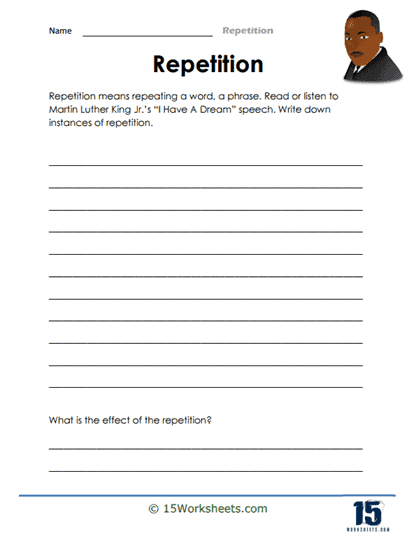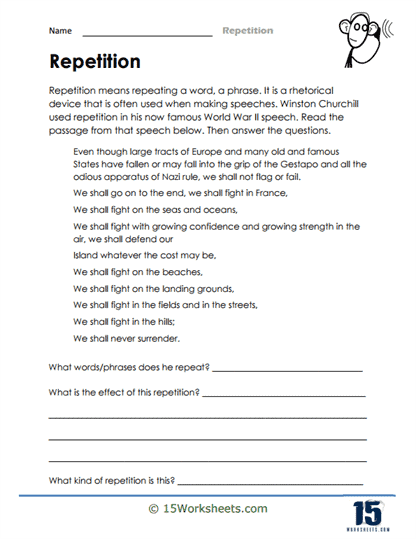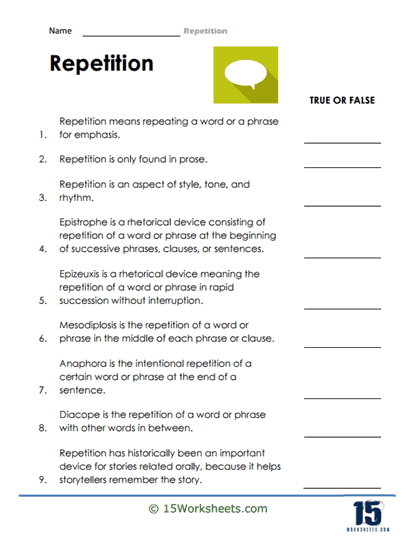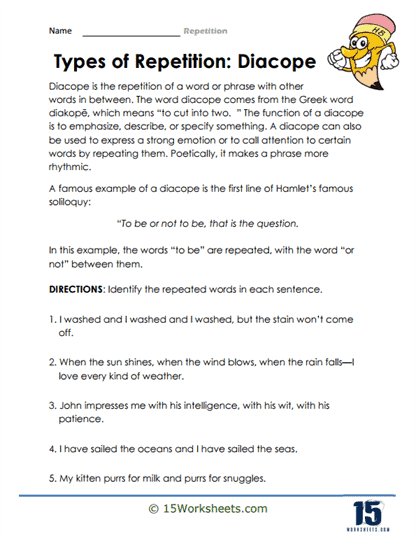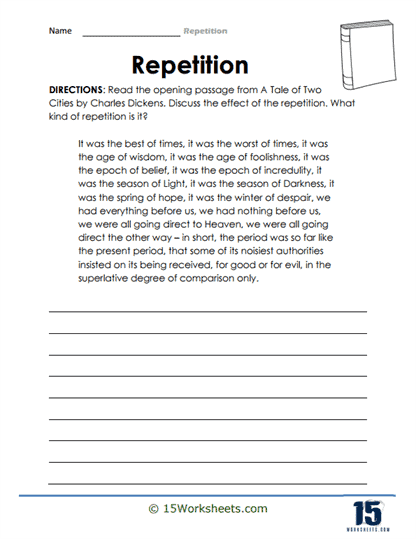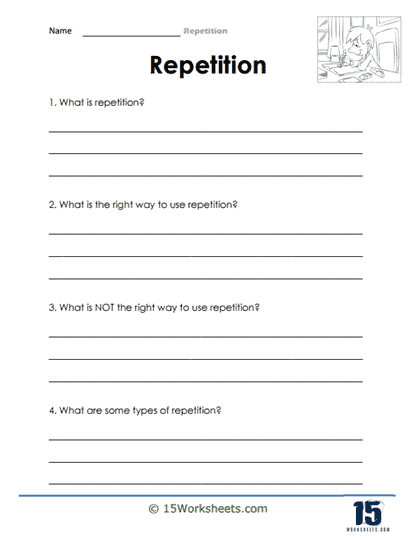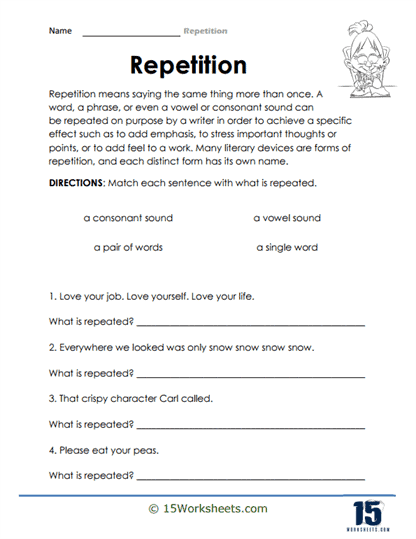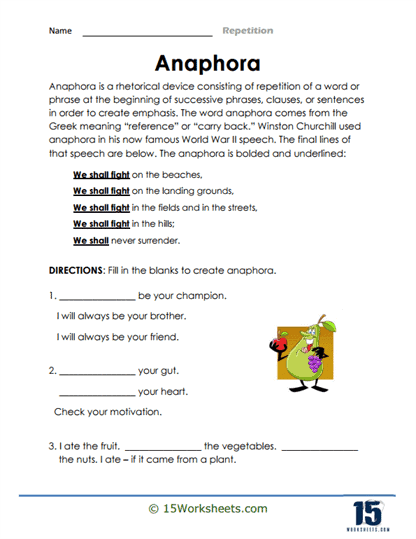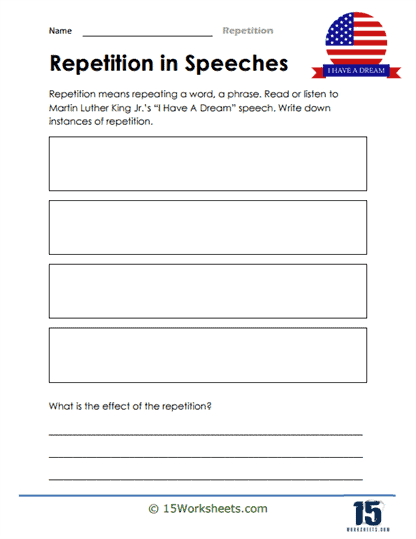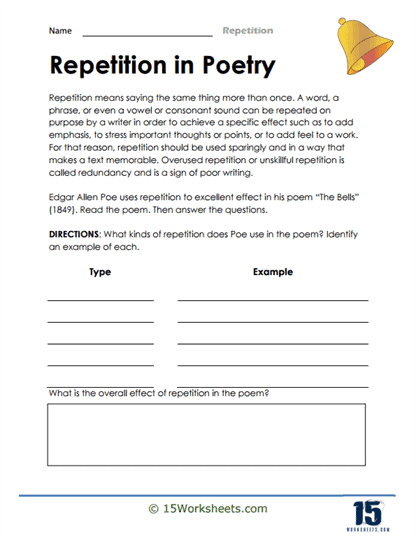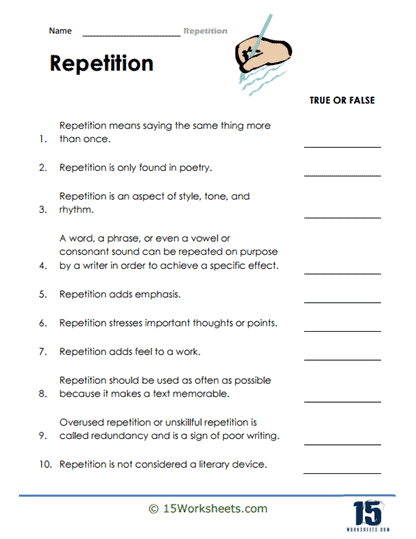Repetition Worksheets
About These 15 Worksheets
These worksheets are designed to reinforce learning through the repeated practice of concepts, vocabulary, grammar, and other language arts skills. These worksheets leverage the principle of repetition, a foundational aspect of learning theory, to help students internalize and master content effectively. By engaging in exercises that repeat certain language arts elements, students can improve their understanding, retention, and application of these skills. Below, we explore the variety of exercises found in repetition worksheets and how these contribute to enhancing students’ language arts and reading skills.
Through a variety of exercises designed to repeat key concepts, vocabulary, and grammatical structures, these worksheets help students internalize and master the material. The benefits of practicing with repetition worksheets extend beyond immediate academic performance, fostering deeper comprehension, increased confidence, and the development of critical reading and thinking skills.
Types of Exercises
Vocabulary Building – These exercises focus on repeating new words in various contexts to improve vocabulary. Activities might include matching words to definitions, using words in sentences, and word-association games. Through repetition, students solidify their understanding of new vocabulary, enhancing their ability to comprehend texts and express themselves more precisely.
Grammar Practice – Grammar exercises on repetition worksheets might involve the repeated application of grammatical rules, such as verb tenses, subject-verb agreement, and the use of adjectives and adverbs. By consistently practicing these rules, students develop a more intuitive grasp of correct grammatical structures, leading to improvements in both writing and speaking.
Reading Comprehension – Worksheets may include short passages followed by questions that students answer multiple times, with slight variations in question framing. This repetition helps students refine their ability to extract key details, understand main ideas, and infer meanings from texts, crucial skills for academic success across subjects.
Phonics and Spelling – Exercises often focus on phonetic patterns, word families, and spelling rules. Activities like filling in missing letters, unscrambling words, and writing words multiple times reinforce phonemic awareness and spelling accuracy, foundational skills for reading and writing proficiency.
Sentence Structure – Repetition worksheets help students understand sentence structure through exercises that involve constructing sentences, identifying sentence types, and rearranging words to form coherent statements. Regular practice strengthens students’ ability to craft varied and complex sentences, enhancing their writing’s clarity and engagement.
Use Of Figures of Speech – Worksheets may repeatedly expose students to literary devices (such as metaphors, similes, personification) and figures of speech, with exercises designed to identify, analyze, and create examples of each. This repetition fosters a deeper appreciation and understanding of literary techniques, enriching students’ reading and writing experiences.
Writing Practice – Repetition worksheets include activities that prompt students to write paragraphs or essays on similar topics with different focuses or to rewrite sentences and paragraphs to improve coherence and style. Through repeated practice, students enhance their writing skills, learning to communicate ideas more effectively.
Reading Fluency – Some repetition worksheets focus on reading fluency through exercises that involve reading the same passage multiple times, each time with a focus on improving speed, accuracy, and expression. This type of repetition is especially beneficial for early readers and English language learners.
Benefits of These Worksheets
Enhanced Retention – Repetition is a key factor in memory consolidation. By engaging with concepts multiple times, students are more likely to remember and recall information when needed, improving performance across all areas of study.
Increased Comprehension – Through repeated exposure to complex concepts and vocabulary, students develop a deeper understanding of the material. This comprehension is crucial for critical thinking and the ability to engage with texts on a more sophisticated level. Regular practice with repetition worksheets builds students’ confidence in their language arts skills. As they become more familiar with grammatical structures, vocabulary, and literary concepts, their anxiety about reading and writing tasks decreases, encouraging a more positive attitude toward learning.
Feedback for Improvement – These worksheets provide opportunities for immediate feedback, whether through self-correction, peer review, or teacher guidance. Feedback helps students identify areas for improvement and refine their skills through further practice.
Customization and Differentiation – Teachers can customize repetition worksheets to target the specific needs of their students, offering differentiated instruction that accommodates varying levels of ability and learning styles. This customization ensures that all students can benefit from repetition exercises.
Building Reading and Writing Habits – Regularly working on repetition worksheets encourages the development of reading and writing habits. As students become accustomed to engaging with texts and writing regularly, these practices become integral parts of their academic routine and lifelong learning. Repetition worksheets facilitate mastery by allowing students to practice until they achieve proficiency. This mastery is essential for foundational skills such as reading, writing, and grammar, which serve as the basis for more advanced study.
What is the Literary Device of Repetition?
The literary device of repetition involves the deliberate reuse of words, phrases, sentences, or structural elements within a text. This technique serves various purposes, from emphasizing a point to enhancing the rhythm and cadence of the writing. Repetition is a powerful tool that authors leverage to add depth to their narrative, draw attention to key themes, and evoke emotional responses from their audience. Understanding the nuances of repetition and its effects on readers offers insights into the craftsmanship of storytelling and poetic expression.
The Defining Features of Repetition
The main defining feature of repetition is the intentional reiteration of specific elements within a text. Unlike accidental redundancy, repetition is a conscious choice by the author to reinforce ideas, create structure, or imbue the text with a particular mood or tone. The effectiveness of repetition lies in its ability to make certain aspects of the text stand out, aiding in memory retention and emphasizing the significance of the repeated element.
Characteristics of Repetition
Emphasis – Repetition can highlight a particular word, phrase, or idea, making it more prominent and signaling its importance to the reader.
Rhythmic Quality – Through repetition, writers can create a musical rhythm in their prose or poetry, enhancing the reading experience and making the text more memorable.
Unity and Cohesion – Repeated elements can tie various parts of a text together, creating a sense of unity and cohesion that guides the reader through the narrative.
Development of Theme – By repeating certain concepts or phrases, authors can reinforce thematic elements, allowing readers to more deeply understand and engage with the underlying messages of the text.
Creation of Mood – Repetition can also be used to build atmosphere and mood, whether it’s a sense of foreboding, excitement, sorrow, or tranquility.
Examples of Repetition in Literature
“Anaphora” in Martin Luther King Jr.’s “I Have a Dream” Speech – Though not a literary text in the traditional sense, King’s use of anaphora—a specific type of repetition where the same word or phrase is used at the beginning of successive sentences or clauses—exemplifies repetition’s power. The repeated use of “I have a dream” not only emphasizes his vision for civil rights and equality but also creates a rhythmic momentum that builds emotional intensity and unity among the listeners. This technique makes the speech memorable and impactful, showcasing repetition’s ability to elevate rhetoric.
“Epistrophe” in Charles Dickens’s “A Tale of Two Cities” – Dickens uses epistrophe, the repetition of a word or phrase at the end of successive clauses, in the famous opening line – “It was the best of times, it was the worst of times, it was the age of wisdom, it was the age of foolishness…” This repetition emphasizes the paradoxes of the era Dickens describes, setting the tone for the novel’s exploration of duality and conflict during the French Revolution. The rhythmic quality of the repetition also draws readers in, creating a memorable and engaging opening.
“Polyptoton” in Shakespeare’s “Hamlet” – Shakespeare frequently employed repetition, including polyptoton, where the same root word is repeated in different forms. In Hamlet’s soliloquy, the phrase “to die, to sleep—To sleep, perchance to dream” showcases this technique. The repetition of “sleep” in close proximity emphasizes the theme of death as a form of escape while introducing the fear of the unknown in death’s “dreams This use of repetition deepens the thematic complexity of the play and highlights Hamlet’s existential dilemma.
The Effect of Repetition on the Reader
Repetition significantly influences the reader’s experience and interpretation of a text. Its effects include:
Enhanced Memory and Comprehension – Repetition makes elements of the text more memorable, aiding in the retention of key themes, ideas, and motifs. This makes it easier for readers to follow and understand the narrative or argument.
Emotional Engagement – By emphasizing certain emotions or moods through repetition, authors can create a more immersive and affective reading experience, eliciting stronger emotional responses from the audience.
Increased Impact and Persuasiveness – In rhetorical contexts, repetition can make an argument more compelling and persuasive, as seen in speeches and persuasive writing. The reinforcement of key points through repetition makes them more convincing and difficult to ignore.
Aesthetic Pleasure – The rhythmic and musical qualities introduced through repetition can enhance the aesthetic pleasure of reading, making the text more enjoyable and engaging.



